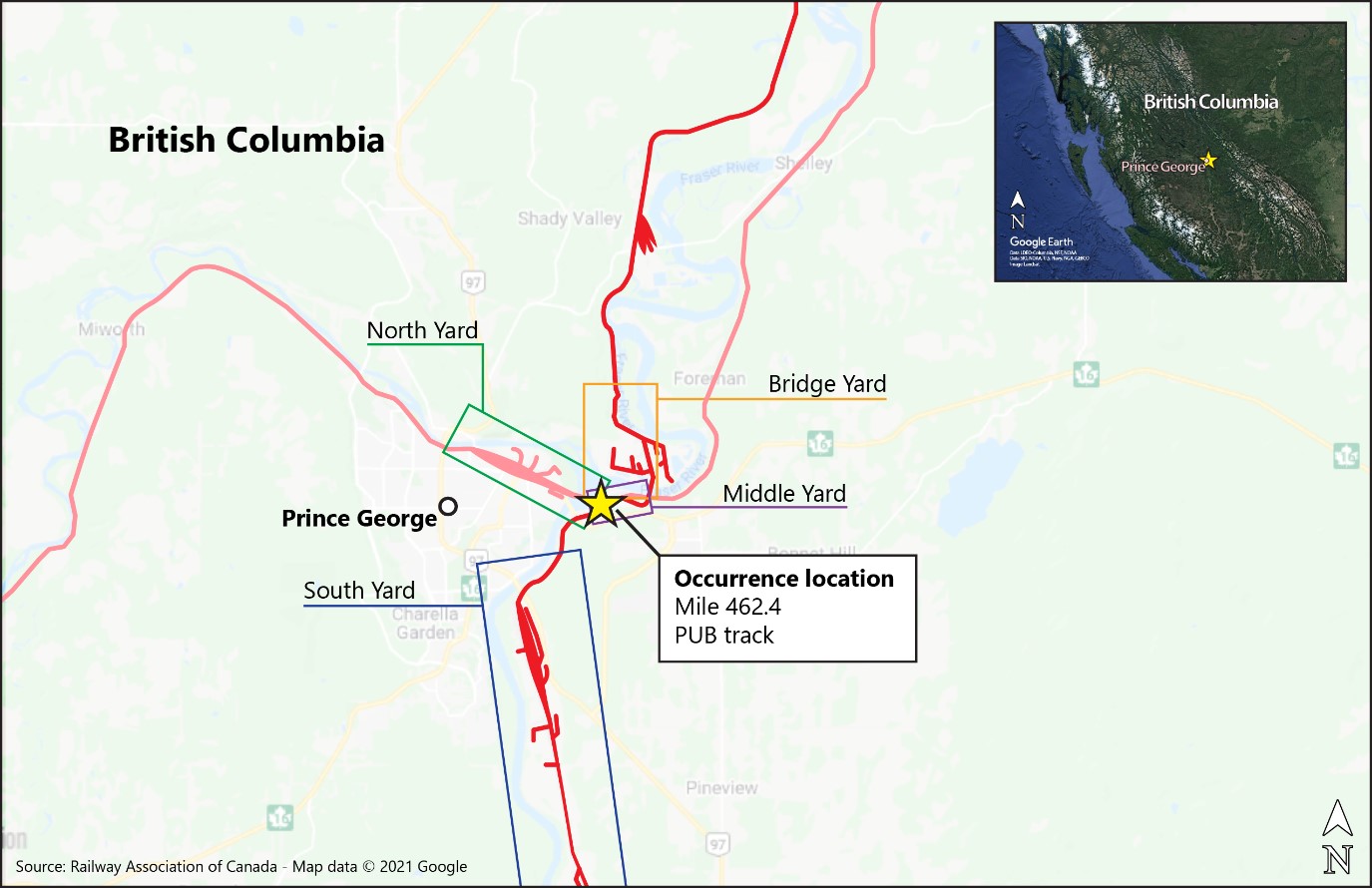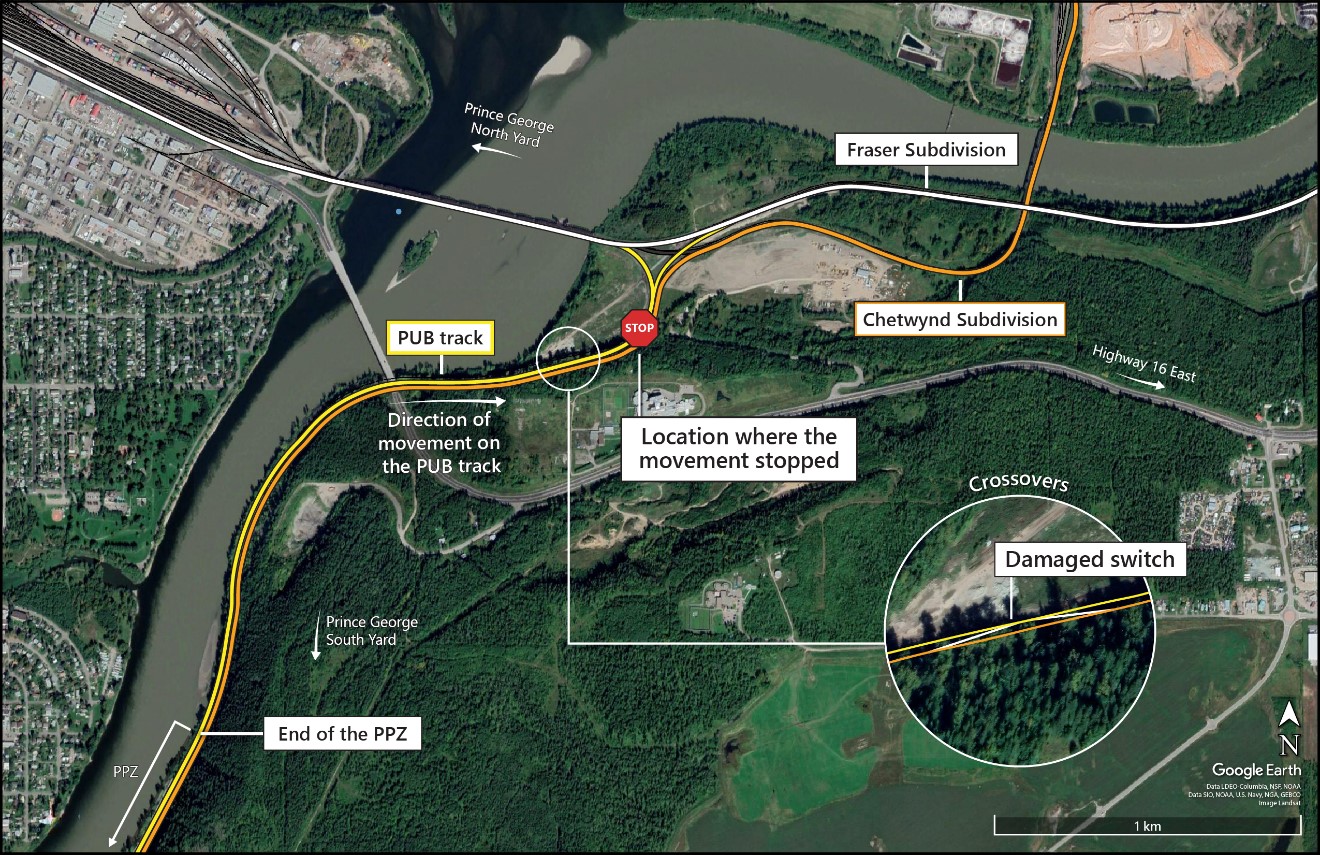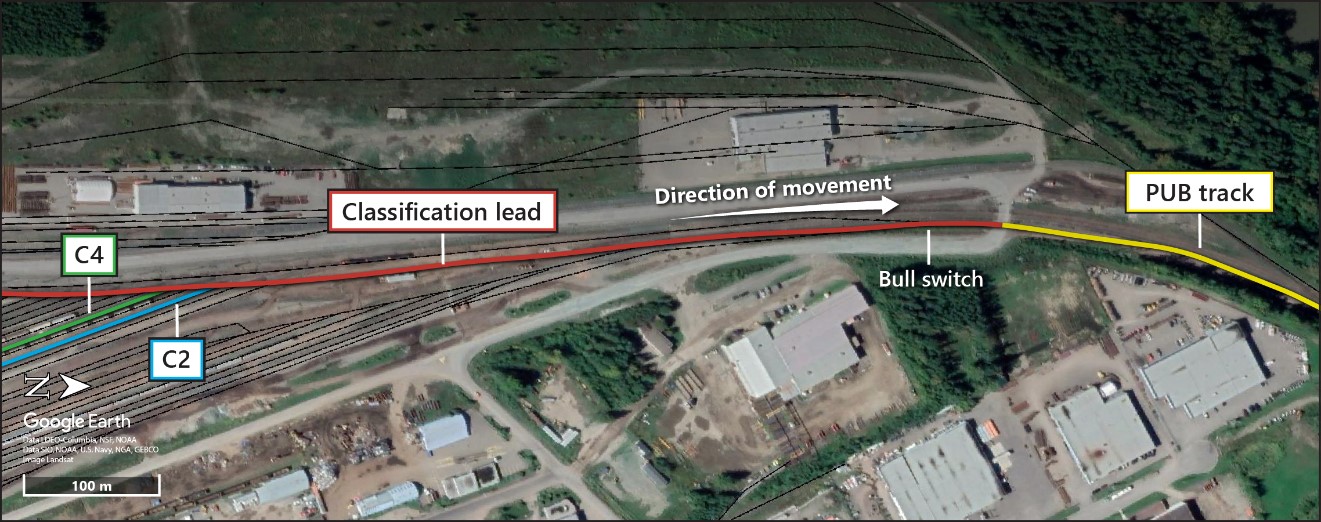Non–main-track uncontrolled movement
Canadian National Railway Company
Remote control locomotive system
Yard assignment 1500 North end
Mile 462.4, Chetwynd Subdivision
Prince George Terminal, South Yard
Prince George, British Columbia
The Transportation Safety Board of Canada (TSB) investigated this occurrence for the purpose of advancing transportation safety. It is not the function of the Board to assign fault or determine civil or criminal liability. This report is not created for use in the context of legal, disciplinary or other proceedings. See Ownership and use of content. Masculine pronouns and position titles may be used to signify all genders to comply with the Canadian Transportation Accident Investigation and Safety Board Act (S.C. 1989, c. 3).
The occurrence
On 13 November 2020 at about 1922 Pacific Standard Time, a Canadian National Railway Company (CN) yard foreman and a helper were performing switching operations in the South Yard of CN’s Prince George Terminal in Prince George, British Columbia (Figure 1), using a remote control locomotive system (RCLS). The foreman was operating yard assignment 1500 North end (the assignment) northward within the limits of a point protection zone (PPZ)Footnote 1 on the PUB trackFootnote 2 when he lost control of the movement. The uncontrolled movement accelerated to approximately 17 mph, ran through a crossover switch that was lined against the movement’s direction of travel, damaging the switch, and subsequently came to a stop about 7200 feet outside the limits of the PPZ and about 1250 feet before the entrance of the main track of the Fraser Subdivision (Figure 2). No dangerous goods were involved, and the movement did not derail. No one was injured.
At the time of the occurrence, the movement consisted of 3 head-end locomotives (CN 7219, CN 7510, and CN 9628) and 50 loaded cars; it measured 2309 feet long and weighed 6850 tons.
Events leading to the uncontrolled movement
The crew was working in the classification yard at the north end of the South Yard. They had been instructed to double overFootnote 3 54 cars (52 loaded cars and 2 empty cars) from track C4 to a cut of cars on track C2. The move required the assignment to proceed past the bull switchFootnote 4 and onto the PUB track (Figure 3). The PUB track is on a hill; the grade varies between 0.49 and 1.13%, with an average descending grade of 0.70%. The grade levels off between the Highway 16 overpass and the end of the PUB track, just before it connects with the main track of the Fraser Subdivision.
The crew, who was controlling the movement using the RCLS, moved the locomotives to the north end of track C4 and coupled them onto the freight cars that were located there. They then held a brief discussion about the switching task. Both crew members were aware of the applicable instructions and the helper raised concerns about the need for air brakes on the rail cars. However, the foreman decided that the locomotive independent brake system on the 3 locomotives would be relied upon exclusively to slow and stop the movement.
The crew began pulling the cut of cars out of track C4. At this point, the foreman realized that 4 cars had been inadvertently left behind, and he used the RCLS to send a stop command. However, the braking effort provided by the locomotives was insufficient and the movement did not stop. When the movement had reached 7 mph, the foreman then sent a command to place the locomotives in emergency, which applies the maximum available locomotive brake effort. The movement accelerated to about 17 mph, then slowed down and eventually came to a stop once it reached the level grade, after having travelled a distance of 15 640 feet.
Weather information
At the time of the occurrence, the ambient temperature was −2.1 °C with a light wind. The sun had set at about 1612 and there was light snowfall throughout the night. Due to the overcast sky and darkness, visibility was limited to approximately 1.5 statute miles.
Crew information
The crew consisted of 2 conductors—one acting as the yard foreman who was in charge of coordinating the switching activities, and the other acting as the helper. Both crew members were qualified for their respective positions, met established fitness and rest requirements, and were familiar with the territory.
At the time of the occurrence, the foreman had been qualified for 3 years and the helper had been qualified for 2 years. Both crew members had been working out of the Prince George Terminal since their hire date.
Prince George Terminal information
The Prince George Terminal is located in Prince George, at the junction of the CN Chetwynd, Fraser, Nechako, and Prince George subdivisions. It consists of 3 main yards: North Yard, South Yard and Bridge Yard. Between the 3 main yards is an area known as the Middle Yard, used by trains and yard assignments when circulating from one yard to another.
The South Yard and the Middle Yard are connected by the PUB track, a section of which is designated as a PPZ. The usable length within the PPZ limits is 6400 feet. In general, the average number of cars that fit in the zone is between 80 and 100, depending on car length.
On the PUB track, near the Middle Yard, a set of crossovers allows northbound and southbound trains and yard movements to cross over from the Chetwynd Subdivision to the PUB track (or vice versa) and to access the Fraser Subdivision.
In the Prince George Terminal, movements are governed by Canadian Rail Operating Rules (CROR) Rule 105, Operation on Non-Main Track. According to this rule, movements within the terminal must be able to stop within one-half the range of vision of equipment or a track unit and must not exceed 15 mph.Footnote 5 Within an active PPZ, where point protection is not required, movements are not required to stop within half the range of vision of equipment or a track unit; however, the maximum authorized speed remains 15 mph.
Operating practices for the use of freight car air brakes when switching
The Prince George Terminal Operating Manual contains instructions that govern operations in the terminal area. Employees working in this area must be familiar with these rules and instructions, have a copy available while on duty, and comply with them. Section 3.2.2 specifies the requirements for operating on the PUB track, including the maximum trailing tonnage and minimum number of cars that must have operative brakes to ensure sufficient braking is available for switching operations. According to these instructions, given the occurrence movement’s length and tonnage, operative brakes on all 3 locomotives and on 4 of the rail cars were needed.Footnote 6
<em>Canadian Rail Operating Rules</em> emergency communication procedures
The CROR contain communication procedures to be followed in emergencies, including when it is necessary to protect against the hazards associated with uncontrolled movements.
When a radio is used to provide protection in an emergency, CROR Rule 125, Emergency Communication Procedures, states, in part:
(a) An employee will transmit the word “EMERGENCY” three times at the beginning of the transmission to indicate the report of;
(i) an accident involving injury to employees or others;
(ii) a condition which may constitute a hazard to employees or others;
(iii) a condition which may endanger the passage of movements; or
(iv) a derailment which has occurred on, or is fouling, a main track.Footnote 7
In this occurrence, the crew had been communicating by radio on the designated channel used for South Yard switching activities. When it became apparent that the assignment was not coming to a stop and was exiting the PPZ, the crew turned their attention to the situation at hand and immediately contacted train 355, which was travelling south on the adjacent Chetwynd Subdivision track, near the location where the runaway movement would have entered the track. The crew did not make an emergency radio call on the train standby channel as required by CROR Rule 125.
TSB Watchlist
The TSB Watchlist identifies the key safety issues that need to be addressed to make Canada’s transportation system even safer. Unplanned/uncontrolled movement of rail equipment is a Watchlist 2020 issue.
Unplanned/uncontrolled movements of rail equipment create high-risk situations that may have catastrophic consequences. Between 2010 and 2019, the trend of unplanned/uncontrolled movements was on an upward trajectory,Footnote 8 with a peak of 78 occurrences in 2019.
Transport Canada and the railway industry have taken some significant actions with additional administrative defences to prevent these occurrences, and actions to mitigate the consequences through the use of physical defences such as derail devices where appropriate. However, the desired outcome—to reduce the number of these types of occurrences—has not been achieved.
ACTION REQUIRED
Unplanned/uncontrolled movement of rail equipment
While all three categories of unplanned/uncontrolled movements share some common causes, they each require unique strategies either to prevent the occurrences from happening or to reduce the associated risks. Transport Canada, the railway companies, and labour unions must collaborate, devise strategies, and implement physical and administrative defences to address each type of uncontrolled movement. For the safety of railway workers and the public, the TSB wants to see a downward trend in the number of such occurrences.
Other occurrence
The TSB investigated another occurrence at the Prince George Terminal where insufficient braking capacity on a cut of cars during a switching operation led to an uncontrolled movement.
On 04 August 2007, a Prince George South Yard RCLS assignment was pulling 53 loaded cars from track PA02 at the north end of the yard. The movement ran away northbound, striking a car loaded with gasoline on CN train M35761-30, derailing it and the next car ahead, also loaded with gasoline. Two locomotives, a slug unit and a loaded centre beam flatcar in the yard consist also derailed. The subsequent fire destroyed the two tank cars, the centre beam flatcar, as well as the two locomotives and slug unit of the yard consist. There were no injuries. Approximately 172 600 litres of fuel (1600 litres of diesel and 171 000 litres of gasoline) were spilled.Footnote 9
At the time of the 2007 occurrence, crews were expected to determine how to handle longer, heavier cuts of cars on their own without adding braking capacity by cutting in the air brake systems of extra cars. Subsequently, the Prince George Terminal Operations Manual was revised to include tables that specify when additional car air brake systems must be cut in to ensure sufficient braking capacity.
Safety action taken
After the 2020 occurrence, CN management carried out a safety blitz for crews operating in the Prince George Terminal, to reinforce the rules and instructions for operating in the PPZ.
In addition, revisions to CROR Rule 113.3 came into force on 28 October 2021, requiring the use of air brakes to control movements during switching on grades greater than 0.4% and with more than 2000 tons.
Safety message
As this occurrence demonstrates, it is important for operators and employees to ensure sufficient braking capacity to enable the control of rolling stock when switching. Furthermore, operating employees must follow emergency communication procedures in order to ensure the safety of other employees working in the area.
This occurrence also highlights why it is important to apply the lessons learned from previous accidents so that employees continue to be aware of the presence of local hazards and adhere to safe operating practices.
This report concludes the Transportation Safety Board of Canada’s investigation into this occurrence. The Board authorized the release of this report on . It was officially released on .


